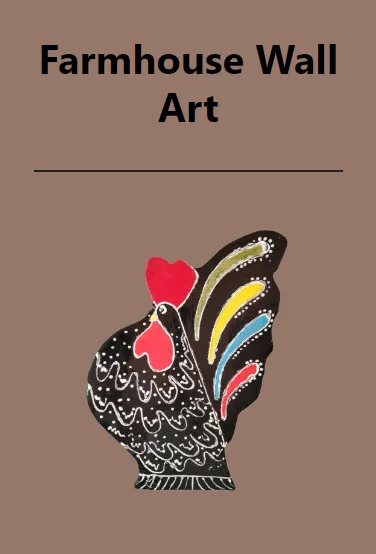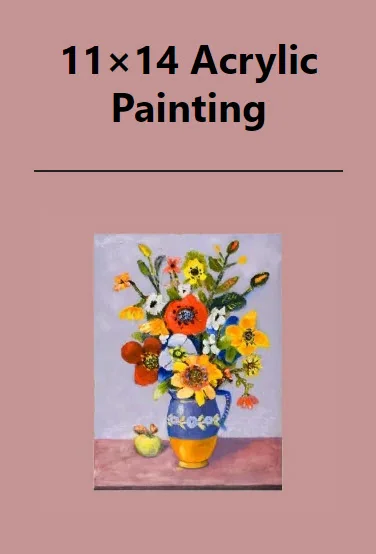They are sturdy, made of durable material like canvas or thick cotton. They should have deep pockets for tools and an adjustable fit. Ideally, they cover both the chest and legs, protecting against clay splashes.
According to David Jackson, Artist and Editor of Artvilla.com, “They are a potter’s trusty sidekick. A good apron has been a game-changer!“
Pros and Cons of Four Types
| Brand | Pros | Cons |
|---|---|---|
| MORNITE MORNITE Apron | – Waterproof and stainproof – Soft and comfortable microfiber/polyester blend – Adjustable straps – Multiple pockets | – May not be as breathable as cotton or canvas – Light gray color may show stains |
| Split Leg Apron | – 100% mid-weight cotton – Breathable and comfortable – Adjustable neck loop and waist tie – 3 big and deep tool pockets – Clever split-leg design | – Only hand wash is available – May not be as durable as canvas |
| Mignongirl Crossback Apron | – Quality soft canvas – Adjustable and removable straps – Two pockets and a utility loop – Unique split apron design | – Only hand wash is available – May not be as breathable as cotton |
1 MORNITE MORNITE
I remember hearing about this one during my time in the pottery community. Here’s what I know:
- Material. One of the standout features of the MORNITE apron is its waterproof material. This is crucial for potters. We’re always dealing with wet clay, slip, and water when throwing on the wheel. An apron that doesn’t let moisture seep through can keep your underlying clothes almost entirely free of dampness.
- Durability. From what I’ve gathered, MORNITE aprons are known for their durability. Pottery is a tactile, messy art. You want an apron that can withstand regular wear and tear, frequent washings, and the occasional accidental brush with sharp tools.
- Design. These aprons often have thoughtful designs that are both functional and stylish. This includes things like adjustable straps for a better fit and pockets for storing tools. Some even have split-leg designs, providing potters with better mobility.
- Versatility. While designed with artists in mind, this apron is versatile enough for other crafts and tasks around the home or workshop. So, even outside the pottery studio, it can find a lot of use.
- Comfort. An apron isn’t just about protection; it’s also about comfort. From what I’ve heard, the MORNITE apron scores well on this front, with many users appreciating its fit and feel during long pottery sessions.
Now, as for it being the “best” apron for potters, I believe that’s a bit subjective. Different potters have different preferences based on their work style, body type, and personal aesthetic. The MORNITE might be perfect for some, while others might lean towards other brands or custom-made options. However, given its features and positive reviews, it’s certainly among the top contenders in the pottery world.
MORNITE MORNITE Apron Specifications
- Color: Light gray
- Closure: Button closure
- Washing: Machine washable and dryer safe
- Waterproof & Stainproof: Yes
- Material: 70% Microfiber / 30% Polyester blend heavy canvas
- Comfort: Soft and comfortable, suitable for long periods of wear
- Straps: Adjustable, measuring 34″ L x 26″ W overall, with 30″ long ties
- Pockets: Sewn-in pouch ideal for storing various items
- Design: Classic design suitable for both men and women
MORNITE MORNITE Pros and Cons
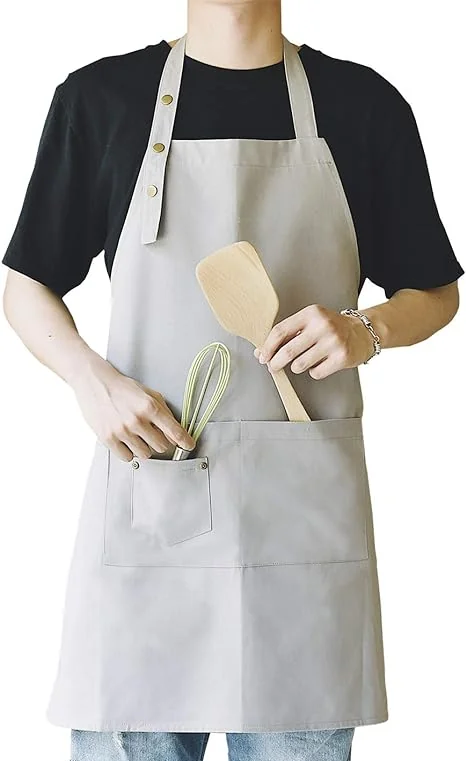
Pros
- Waterproof & Stainproof: Protects your clothes from getting wet or stained.
- Soft Fabric: Made of a comfortable Microfiber/Polyester blend.
- Adjustable Straps: Features an adjustable strap for a perfect fit. Maybe-see Cons section.
- Multi-Purpose: Suitable for various activities beyond pottery.
Cons
- Breathability: Being synthetic, it may not be as breathable as natural fibers like cotton or canvas.
- Complexity in Adjusting Straps: The three-level shoulder strap snaps might be complex for some users to adjust. Also if the neck strap has only 3 snaps.
- Style Preference: None, plain apron. Looks like you are going to work and not having fun crafting.
- Pockets: One nice large pocket and one tiny pocket. The small pocket is so small. The one larger pock it great.
2 Split Leg Apron
The split-leg apron! I remember the first time I slipped one on; it felt a bit like donning a pair of chaps!
But once you get past the initial amusement, the practicality becomes evident.
A split-leg apron, as the name suggests, has a split running up the front, which essentially gives it two separate leg coverings.
It looks somewhat like a combination of an apron and a pair of pants.
It really boils down to personal preference. Some potters swear by their split-leg aprons, while others are just as content with their traditional ones. But I’d say, if you have the opportunity, give the split-leg a try! You might find it’s just the thing you didn’t know you were missing in the studio.
Split Leg Pottery Apron Specifications
- Material: 100% mid-weight cotton
- Closure: Drawstring
- Washing: Machine washable
- Comfort: Breathable and comfortable for long periods of wear
- Colors: Available in black, green, and blue
- Straps: Adjustable neck loop, long waist tie straps
- Design: Clever split-leg design for comfort while sitting
- Pockets: One front chest pocket and two large side pockets
- Applications: Suitable for a wide range of activities and professions
Split Leg Apron Pros and Cons
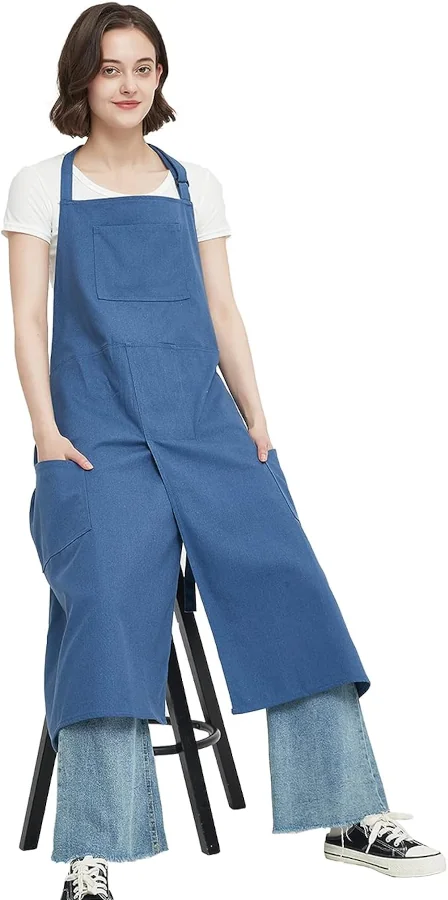
Pros
- Made of 100% mid-weight cotton, offering breathability and comfort.
- Features an adjustable neck loop and long waist tie straps for a custom fit.
- Designed with a clever split-leg feature for added comfort while sitting.
- Equipped with three large and deep tool pockets for convenient storage.
- Suitable for a wide range of activities and professions.
Cons
- May require machine washing, which could affect its durability over time.
- Lacks water or stain resistance, unlike some other materials.
- Available in only three colors (black, green, blue), which may limit style choices.
The advantages of using a split-leg apron in pottery:
- Mobility. This is the big one. The split design allows for greater freedom of movement. You can comfortably straddle the wheel or sit in various positions without feeling restricted. This is especially helpful during long sessions at the wheel.
- Coverage. Traditional aprons can sometimes shift to the side, leaving parts of your pants exposed, especially when you’re deeply engrossed in centering that stubborn piece of clay. The split-leg design offers more consistent coverage down the front of both legs.
- Adaptability. Whether you’re throwing at the wheel, hand-building at a bench, or glazing, the design of the split-leg apron fits all scenarios. It adapts to various sitting and standing positions more effectively than a regular apron.
- Less Heat. Pottery studios can get warm, especially in the summer or when kilns are firing. The open design of the split-leg apron can be cooler than a full apron which wraps around you.
- Easy to Put On and Take Off. Unlike some protective gear, a split-leg apron often comes with easy-to-use buckles or ties, making it quick to don and doff.
- Safety. In certain situations, the split-leg design might reduce the chances of tripping or getting caught on equipment compared to a wider, traditional apron.
How does the split apron design help while working with clay on a work bench?
The split apron is quite the game changer, especially when working with clay on a workbench. Here’s how:
- Easy Transition Between Tasks. In pottery, you might find yourself moving from the wheel to hand-building tasks on a bench, or even to glazing areas. A split apron is versatile and ensures you’re adequately covered and comfortable, regardless of the task.
- Keeps You Cleaner. Because of its design, a split-leg apron generally offers a wider coverage area than a traditional apron. This means less clay on your clothes at the end of a session.
3 Mignongirl Crossback
The Mignongirl Crossback is not one of the most commonly discussed aprons in my circle, but I’m familiar with crossback designs, which are quite versatile.
Here’s the deal: The main purpose of an apron, no matter the craft, is to provide protection to the wearer’s clothes and, sometimes, to offer convenient storage for tools. So, the question isn’t really about what the apron is marketed for, but about its features.
- Crossback Design. Mignongirl Crossback Apron is fantastic for pottery. No ties around the neck means no strain there, and it distributes the apron’s weight across the shoulders. For long pottery sessions, this design can be quite comfortable.
- Coverage. Ideally, for pottery, you’d want an apron that offers ample coverage, especially in the front. The Mignongirl’s design seems to be generous, which is great for protecting your clothing from splashes and splatters of clay.
- Material. The material used is crucial. If it’s too thin, it might not offer enough protection from wet clay. If the Mignongirl Crossback Apron is made from a thick, durable material, it’s a plus.
- Pockets. Potters love pockets! They’re great for holding tools, especially those frequently used.
Mignongirl Crossback Apron Specifications
- Material: Quality soft canvas
- Washing: Hand wash only
- Protection: Full coverage for clothing protection
- Pockets: Two pockets for storing small items and a utility loop for tools
- Straps: Adjustable and removable, fits sizes M-XXL
- Closure: Quick-release hardware buckle fastener
- Design: Unique split apron design for seated activities
- Applications: Suitable for home, kitchen, restaurant, salon, cosmetology, coffee shop, flower shop, bar, bistro, farmhouse, garden, etc.
Mignongirl Crossback Pros and Cons
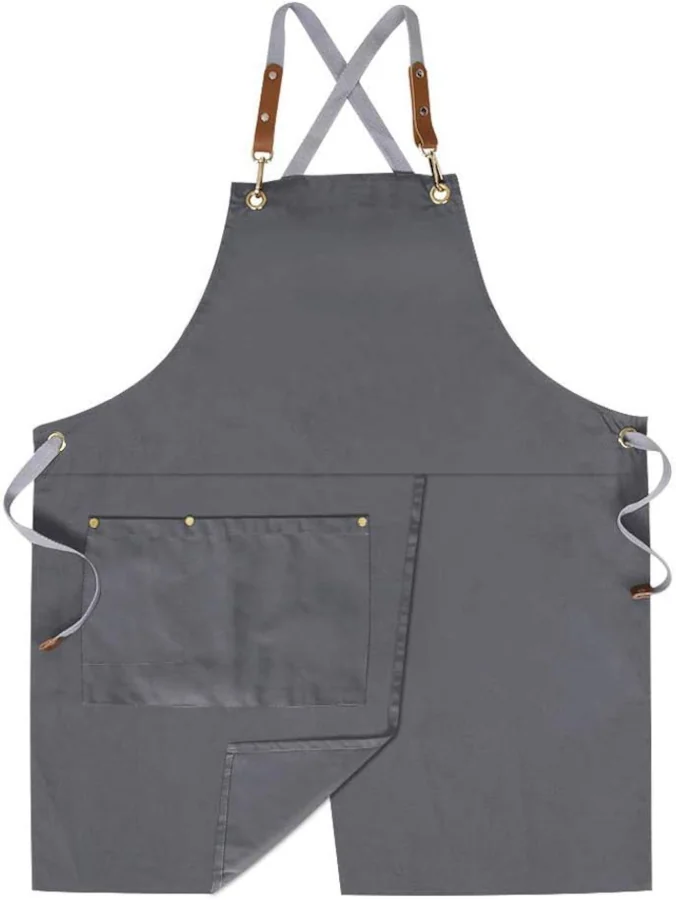
Pros
- Made of quality soft canvas, offering durability and comfort.
- Features adjustable and removable straps for a custom fit, suitable for sizes M-XXL.
- Equipped with two pockets and a utility loop for convenient storage.
- Unique split apron design adds convenience when sitting.
- Versatile, suitable for a variety of settings like home, kitchen, restaurant, salon, and more.
Cons
Hand wash only, which may be less convenient for some users.
Lacks breathability compared to cotton materials.
No mention of water or stain resistance, unlike some other materials.
What is The Best Material?
Well, from my experience, I’ve tried a little bit of everything, and I’ve got some thoughts.
Cotton. This is a popular choice and with good reason. Cotton aprons are generally breathable and comfortable. The good news is, yes, clay does wash out of cotton quite well, especially when it’s wet. However, if the clay has dried on your apron, give it a good shake or brush off before washing. Over time though, constant exposure to clay and frequent washing might cause the cotton to wear out a bit faster.
Canvas. This is my personal favorite. It’s durable and can handle the rigors of a pottery studio. Clay splatters and smudges can be brushed off when dried, and if you need to wash it, clay comes out pretty well. But always remember to remove as much dry clay as possible before washing. Canvas can be a bit heavier than cotton, so ensure it feels comfortable, especially if you’re wearing it for extended periods.
Denim. Similar to canvas in terms of durability. It’s a bit stylish, too, if that matters in the studio! Clay can be washed out of denim, but remember, darker clays might leave a slight stain. Pre-washing denim aprons before using them helps to reduce the risk of any dye transfer onto your pots.
Synthetic Blends. Some modern aprons use blends of synthetic materials, which can offer water resistance. Clay can often be wiped off easily when wet. However, they might not be as breathable as cotton or canvas, so consider your comfort if you’re in a warm studio environment.
So, will clay wash out? For most aprons made of the materials I mentioned, yes, it will. But a trick from my years in the studio: Always let the clay dry and then brush or shake off as much as you can before washing. Plus, I pre rinse outside as not to get any clay in my plumbing. This not only protects your washing machine but also ensures a longer life for your beloved apron. And trust me, over the years, that apron becomes like an old friend!
Pros and Cons of Different Materials for Pottery Aprons
| Material | Pros | Cons |
|---|---|---|
| Cotton | Breathable, Easy to Clean, Comfortable | Durability, Requires shaking off dried clay |
| Canvas | Durable, Easy Maintenance, Personal Preference | Weight, Pre-Wash Requirement |
| Denim | Durable, Stylish, Washable | Staining, Dye Transfer |
| Synthetic Blends | Water Resistance, Easy to Clean | Lack of Breathability, Comfort |
Cotton
Pros
- Breathability: Cotton aprons are breathable, making them comfortable to wear for extended periods.
- Easy to Clean: Clay washes out of cotton quite well, especially when wet.
- Comfort: Cotton is generally a soft material, adding to the comfort factor.
Cons
- Durability: Frequent washing and exposure to clay can cause the material to wear out faster.
- Dried Clay: Requires shaking or brushing off dried clay before washing.
Canvas
Pros
- Durability: Canvas is highly durable and can withstand the rigors of a pottery studio.
- Easy Maintenance: Dry clay can be easily brushed off, and the material washes well.
- Personal Preference: This is your personal favorite, adding a touch of expertise to the recommendation.
Cons
- Weight: Canvas can be heavier than cotton, which might be uncomfortable for some.
- Pre-Wash Requirement: Needs to be shaken or brushed to remove dry clay before washing.
Denim
Pros
- Durability: Similar to canvas in terms of longevity.
- Stylish: Offers a stylish look for those who care about aesthetics in the studio.
- Washable: Clay can be washed out, though darker clays may leave stains.
Cons
- Staining: Darker clays might leave a slight stain on the material.
- Dye Transfer: Pre-washing is required to reduce the risk of dye transfer onto pots.
Synthetic Blends
Pros
- Water Resistance: Offers some level of water resistance, making it easier to wipe off wet clay.
- Easy to Clean: Clay can often be wiped off easily when wet.
Cons
- Breathability: May not be as breathable as cotton or canvas, which could be uncomfortable in warm studios.
- Comfort: The material might not feel as comfortable as natural fibers like cotton or canvas.
Material and Care Guide
When choosing the perfect apron for your pottery endeavors, the material is a crucial factor to consider. Different materials have their own sets of advantages and disadvantages, and knowing how to care for them can extend the lifespan of your apron. Here’s a guide to help you make an informed decision:
Cotton Aprons
Pros:
- Breathable and comfortable for extended wear.
- Easy to wash; clay washes out well when wet.
Cons:
- May wear out faster with frequent washing and exposure to clay.
Care Tips:
- Machine washable.
- If clay has dried on the apron, shake or brush it off before washing.
Canvas Aprons
Pros:
- Durable and can handle rigorous use.
- Clay splatters can be easily brushed off when dry.
Cons:
- Heavier than cotton, which may be uncomfortable for long periods.
Care Tips:
- Machine washable.
- Remove as much dry clay as possible before washing.
Denim Aprons
Pros:
- Durable and stylish.
- Clay can be washed out easily.
Cons:
- Darker clays might leave stains.
Care Tips:
- Pre-wash before first use to reduce dye transfer.
- Machine washable.
Synthetic Blend Aprons
Pros:
- Water-resistant and easy to wipe clean.
- Durable and long-lasting.
Cons:
- May not be as breathable as natural fibers like cotton or canvas.
Care Tips:
- Check the care label for specific washing instructions, as synthetic blends can vary.
Microfiber Aprons
Pros:
- Soft and comfortable for long periods of wear.
- Water and stain-resistant.
Cons:
- May require special care to maintain water resistance.
Care Tips:
- Machine washable but check care labels for specific instructions.
What is the Difference Between an Apron and a Half Apron?
the full apron versus the half apron! Over the years, I’ve seen plenty of both in the studio. Each has its merits and drawbacks, and the choice really depends on personal preference and the kind of pottery work you’re involved in. Let me break it down for you:
- Full Apron
- Coverage. A full apron provides coverage from the chest or neck down to around the knees or even further. It’s the more protective choice if you’re prone to splashing clay and slip all over, especially on your upper body.
- Pockets. Many full aprons have pockets at the chest or waist level. This is convenient for keeping tools or even just a damp sponge at arm’s reach.
- Protection. Beyond just clay, a full apron can protect you from minor splashes of glazes or chemicals, which is handy if you’re involved in the glazing process as well.
- Consideration. It might feel a bit bulkier or hotter, especially in a warm studio environment.
- Half Apron
- Coverage. A half apron typically covers from the waist down to the knees. It’s perfect if you mainly have clay splatter on your lower half while working at the wheel.
- Cooler. Given it’s half the fabric, it can feel cooler and less constrictive, which is a boon in a warm studio.
- Easy On and Off. With less fabric to contend with, half aprons can be quicker to put on and take off.
- Pockets. Just like full aprons, many half aprons come equipped with pockets for tools, which can be even more accessible given the apron’s shorter length.
- Consideration. It doesn’t offer any protection to your upper body, so shirts might get splashed or stained.
What’s My Preference for Pottery?
Both styles can be effective for pottery. The decision hinges on the type of pottery work and personal comfort. However, I prefer a full apron. For instance, if you’re primarily at the wheel, a full apron will suffice since most of the splatter is directed toward the lower half of the body. But if you’re engaging in more varied tasks like hand-building, glazing, or even mixing clay and slips, a half apron could offer good enough protection.
Over my many clay-splattered years, I’ve leaned towards a full apron for the sheer versatility. But I’ve had colleagues who’ve sworn by their trusty half aprons. It’s like choosing a favorite pottery tool, sometimes it’s just about the feel and fit that’s right for you.
What is a Baker’s Apron?
The baker’s apron! Now, that’s something I’ve encountered in more contexts than just the pottery studio. Having a penchant for bread-making myself, I’ve used one while kneading dough on many occasions. Here’s my thoughts about the baker’s apron:
Baker’s Apron
- Design. Traditionally, a baker’s apron is a full apron, often made of thick, sturdy cotton or linen. It provides coverage from the chest or neck down to the knees, or sometimes even the ankles.
- Pockets. Not all baker’s aprons have pockets, as bakers often need a smooth surface to wipe their hands on without the interference of seams or pockets. However, some modern designs might include one or two.
- Straps. One hallmark of many baker’s aprons is a cross-back design. Instead of a strap going around the neck, which can strain over time, the straps cross over the back, distributing weight more evenly.
- Purpose. It’s designed primarily to protect against flour, dough, and occasional wet spots during the baking process.
Can I use a Baker’s Apron for Pottery?
| Feature/Aspect | Pottery Apron | Chef Apron |
|---|---|---|
| Coverage | Full and longer design | Varies, often stops at the waist |
| Material | Water-resistant (e.g., canvas) | Cotton or blends |
| Design & Features | Split legs, tool pockets | Pockets for kitchen tools |
| Neck Support | Crossback/adjustable neck straps | Often a loop or crossback |
| Best for… | Working with clay, wheel throwing | Cooking, baking and pottery |
| Examples | MORNITE Waterproof Art Apron | Artabys Mud Slinger apron |
| Style | Looks like, well you know | Walk around feeling great because you are in style and looking great! |
While not explicitly designed for pottery, a baker’s apron can serve quite effectively in the studio for a few reasons:
- Full Coverage. The full length protects most of your front side, which is particularly useful if you’re engaging in tasks that might splatter or spill, like glazing or wheel throwing.
- Comfort. The cross-back design can be more comfortable for extended periods, especially if you’re bending or leaning forward.
- Material. The thick fabric often used in baker’s aprons can be excellent for handling damp clay, though it may take longer to dry if thoroughly soaked.
However, do consider that a dedicated potter’s apron, especially those with split-leg designs, might offer more mobility and specific features tailored to the needs of potters.
That said, if you have a baker’s apron lying around, there’s no harm in giving it a spin at the wheel! Over the years, I’ve learned that sometimes the best tools and gear aren’t always the ones specifically designed for the job.
Are Pottery Aprons designed differently than Chef Aprons, and if so how?
With my years in the pottery world, I’ve tried many aprons and have observed some distinct differences between those used for pottery and those used in the kitchen.
- Coverage.
- Pottery Aprons. Tend to have a fuller and longer design. Pottery, especially when thrown on a wheel, can be a messy business. You’ve got water, slip, and clay splattering, so a full-length apron that covers a large portion of your front is beneficial. Some even extend to cover the sides of the legs.
- Chef Aprons. While they also offer a good deal of coverage, the primary focus is the front upper body and waist. There are long chef aprons, but some styles stop at the waist, especially those used for quick kitchen tasks.
- Material.
- Pottery Aprons. They’re often made of thicker, water-resistant materials, like canvas or certain synthetic fabrics. The idea is to prevent wet clay from seeping through to your clothing.
- Chef Aprons. Made from a variety of materials, often cotton or a blend. They’re designed to be comfortable, easy to move in, and sometimes flame-resistant.
- Design & Features.
- Pottery Aprons. You’ll often find styles with split legs, allowing potters more freedom of movement at the wheel or bench. They might also have specialized pockets for tools or loops to hang tools from.
- Chef Aprons. These aprons usually feature pockets, but they’re often designed for things like thermometers, pens, or a towel. The ties might be longer, allowing the apron to be wrapped and tied in front.
- Neck Support.
- Pottery Aprons. Many potters favor cross-back designs or adjustable neck straps to reduce neck strain during long sessions.
- Chef Aprons. Often come with a loop that goes around the neck, although cross-back designs are becoming more popular in the culinary world too.
Can I use a Baker’s Apron for Pottery Class?
Here are my thoughts:
- Coverage. Baker’s aprons tend to be full-length, which is fantastic. When you’re at the wheel or hand-building, clay has this sneaky way of getting… well, everywhere. A full-length apron, especially one that’s a bit broader, can save your outfit underneath from clay splatters and spills.
- Material. A baker’s apron is typically designed to ward off flour, dough, and wet patches. Similarly, in pottery, you’re dealing with wet clay, slip, and glaze. The thick fabric of a baker’s apron can handle damp clay well. However, it may retain moisture for a bit longer, especially if it gets really wet.
- Comfort. One thing I absolutely adore about many baker’s aprons is the cross-back design. Instead of a strap that hangs around the neck and can sometimes pull or strain, the cross-back design distributes the weight more evenly. This can be a blessing during long pottery sessions.
- Mobility. Here’s where things get a bit tricky. While the baker’s apron provides ample coverage, it doesn’t offer the same mobility as a split-leg apron designed for potters. If you’re primarily working at the wheel, this might not be a big deal. But if you’re moving around the studio, kneeling, or changing positions often, the split-leg design of a potter’s apron can be more accommodating.
- Pockets. Some baker’s aprons might lack pockets since bakers usually need a smooth surface to wipe their hands. Pockets can be handy in a pottery setting for tools, but they can also collect clay if you’re not careful.
In conclusion, while a baker’s apron might not be the traditional choice for pottery, it can certainly do the job, especially if it’s what you have on hand. If you’re just starting out or attending a beginner’s class, it’s a great way to get your feet wet without committing to specialized gear. But as you dive deeper into the world of pottery, you might find yourself gravitating towards aprons or gear tailored more to the specific demands of the craft.
And just remember, I say, pottery is as much about personal expression as it is about technique. Wear what makes you feel comfortable, confident, and ready to create!
About the Author: Ed Shears
Hello, I’m Ed Shears, the creative force behind Artabys.com, a platform dedicated to promoting visual arts education and awareness. With a robust foundation in traditional pottery techniques, my true passion lies in creating unique ceramic wall art. Each piece I create is handbuilt with meticulous attention to detail, embodying originality and craftsmanship.
Credentials and Experience
- Education: A dedicated student of ceramic arts, my skills have been honed through rigorous training and hands-on experience.
- Artistic Philosophy: I believe in the unparalleled beauty of handcrafted original artwork, which not only adds a unique touch to living spaces but also resonates with the soulful touch of its creator.
- Achievements: I am a renowned author and contributor at Academia.edu and have showcased my artwork at Fine Art America since 2015.
For more about me and my work, feel free to visit my full artist page.
References
How to make pottery White, Mary. How to make pottery. Doubleday, Page, 1904.
The Potter’s Bible: An Essential Illustrated Reference for Both Beginner and Advanced Potters Scott, Marylin. The Potter’s Bible: An Essential Illustrated Reference for Both Beginner and Advanced Potters. Quarto Publishing Group USA, 2006.

